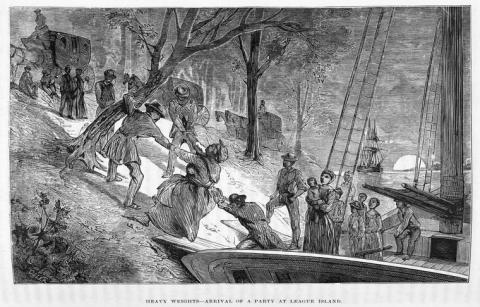Escaping slaves, depicted in this illustration, arrive at League Island (near Philadelphia). They had escaped by schooner, following an Underground Railroad route to freedom. Image online, NYPL Digital Gallery.
It was extremely difficult for escaping slaves to know who could be trusted. Were sympathetic whites legitimate abolitionists - or - were they merely opportunistic folks looking for award money? How to distinguish those differences was sometimes impossible.
Slaves who owned nothing, but longed to be free, faced incredible risks. How would they leave? What provisions would they need? How far would they travel before someone helped? What would happen if the “master” quickly learned of their departure?
Escaping was a dream, but how would it become reality? And even if escape were possible, the choice between staying or leaving was not as simple as it may seem today.
Individuals working the Underground Railroad - that incredibly important network of people who helped escaped slaves stay in safe places as they journeyed to “free states” in the north (or to Canada where American Fugitive Slave Laws were unenforceable) - used railway terms for what they did:
- Travel routes were called "lines"
- Stopping places were called “stations”
- Escaped slaves were called “passengers” or “cargo”
- Key people who helped were called “conductors”
Harriet Tubman, one of the most important conductors on the Underground Railroad, was once a slave herself. Let’s meet her, plus several other leading people who risked serious punishment to do what was right.


 Back
Back
 Next Chapter
Next Chapter

 Back
Back
 Next Chapter
Next Chapter

